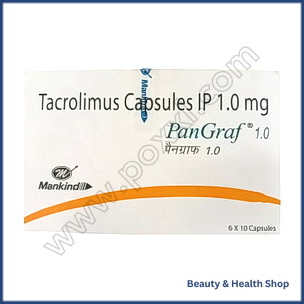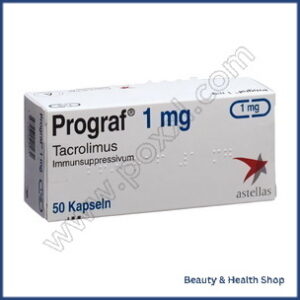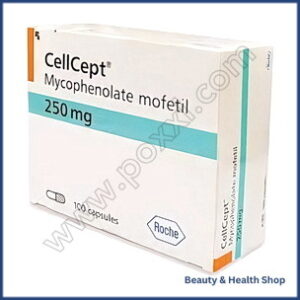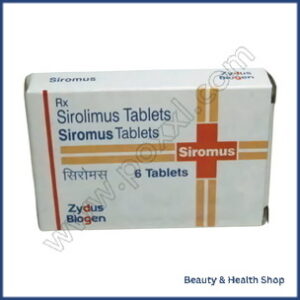ADDICTION
ALCOHOL DEPENDENCE
QUIT SMOKING
ALLERGY
ANTI FUNGAL
FUNGAL INFECTION
FUNGAL NAIL INFECTIONS
ANTI-REJECTION DRUGS
ANTI WORM
ANTIBIOTIC
BACTERIAL INFECTIONS
ARTHRITIS
GOUT
OSTEOARTHRITIS
RHEUMATOID ARTHRITIS
BLOOD
LOW PLATELET COUNT
THROMBOPHLEBITIS
VARICOSE VEINS
COLON
ANAL FISSURE
PILES
ULCERATIVE COLITIS
DIABETES CARE
DIABETES INSIPIDUS
DIABETES TYPE
DIABETIC FOOT ULCERS
GLUCOSE MONITOR
EYES/EAR CARE
DRY EYES
EYE CARE
EYE EXAMINATION
EYE INFECTION
EYE LASHES
EYE PAIN
GLAUCOMA
OCULAR HYPERTENSION
UVEITIS
FEVER CARE
MALARIA
RHEUMATIC FEVER
TYPHOID FEVER
GASTROINTESTINAL
ACIDITY
CONSTIPATION
CROHN'S DISEASE
DIARRHOEA
GALLBLADDER STONES
INTESTINAL ULCERS
IRRITABLE BOWEL SYNDROME
MOTION SICKNESS
NAUSEA
Pangraf 1 mg (Tacrolimus)
| Active Ingredient (Generic Name): | Tacrolimus |
|---|---|
| Indication: | Prevention of organ rejection in transplant patients |
| Manufacturer: | Panacea Biotech Ltd. |
| Packaging: | 10 capsules in one strip |
| Strength: | 1 mg |
From: $56.00
Pangraf 1 mg (Tacrolimus) is an immunosuppressant vital for preventing organ rejection after transplants. Your doctor will customize the dosage based on your needs. Take it orally on an empty stomach, swallowing the capsule whole with water. Don’t crush or chew it; follow the schedule precisely. Besides transplants, Tacrolimus manages skin conditions and autoimmune diseases. Monitor blood pressure and kidneys, and avoid grapefruit. If missed, dose promptly without doubling up. Safely store away from light and moisture. Seek urgent help for overdose. Purchase only from licensed sources for authenticity. A smooth experience guarantees medication quality and effectiveness.
To investigate this topic, let’s begin by examining its fundamentals. When starting a discussion on Tacrolimus, it’s important to understand its primary role as an immunosuppressant medication. Tacrolimus works by suppressing the immune system to prevent it from attacking transplanted organs, making it a key component in organ transplant patients‘ treatment plans.
Furthermore, Tacrolimus is commonly prescribed to prevent organ rejection after a transplant surgery. It’s particularly effective in kidney, liver, and heart transplants. By inhibiting certain immune responses in the body, Tacrolimus helps ensure the transplanted organ’s acceptance and long-term function.
Patients taking Tacrolimus must adhere strictly to their prescribed dosage and schedule. Deviating from the recommended guidelines can lead to serious health complications, including rejection of the transplanted organ. Regular monitoring of Tacrolimus levels in the blood is essential to guarantee its efficacy and prevent adverse effects.
Efficacy of Tacrolimus
When evaluating the effectiveness of Tacrolimus, it’s essential to assess its impact on preventing organ rejection post-transplant surgery, especially in kidney, liver, and heart transplant recipients. Tacrolimus, a potent immunosuppressant medication, works by inhibiting the activity of certain immune cells that would otherwise attack and reject the transplanted organ. Studies have shown that Tacrolimus plays a vital role in improving the success rates of organ transplants by reducing the risk of rejection.
In kidney transplant recipients, Tacrolimus has been particularly effective in preventing acute rejection episodes and maintaining long-term graft function. Similarly, in liver transplant patients, Tacrolimus has demonstrated significant efficacy in preventing rejection and ensuring the viability of the transplanted liver. Heart transplant recipients also benefit from Tacrolimus therapy, which helps to reduce the likelihood of rejection and allows for better outcomes post-surgery.
Why is this medication prescribed?
Prescribed to prevent organ rejection after transplant surgery, Tacrolimus is a potent immunosuppressant medication. When you undergo an organ transplant, your body’s immune system sees the new organ as a foreign invader and tries to attack it. This is where Tacrolimus comes in. By suppressing your immune system’s response, Tacrolimus helps to prevent this rejection and allows your body to accept and integrate the transplanted organ successfully.
Tacrolimus is commonly prescribed for patients who’ve received kidney, liver, or heart transplants. It’s vital in these cases to make sure that the transplanted organ functions properly without being rejected by the body. Your healthcare provider will determine the appropriate dosage of Tacrolimus based on various factors such as your medical history, other medications you may be taking, and how your body responds to the treatment. It’s important to follow your doctor’s instructions carefully when taking Tacrolimus to maximize its effectiveness and minimize the risk of complications.
How should this medicine be used?
For optimal results, take Pangraf 1 mg (Tacrolimus) exactly as instructed by your healthcare provider. This medication is usually taken by mouth on an empty stomach, at least 1 hour before or 2 hours after a meal, typically twice daily. Remember to take it at the same times each day. Swallow the capsules whole with a full glass of water; don’t crush, chew, or break them. The dosage prescribed is based on your medical condition, response to treatment, and blood levels of tacrolimus. It’s essential to follow the dosage instructions provided by your doctor to make sure the medication works effectively.
Do not abruptly stop taking Pangraf without consulting your doctor, as this may lead to serious complications. If you miss a dose, take it as soon as you remember, but skip it if it’s almost time for the next dose. Never take a double dose to compensate for a missed one. Keep all appointments with your healthcare provider for monitoring your progress and any necessary dose adjustments.
Other uses for this medicine
To explore additional applications, consider the versatility of Pangraf 1 mg (Tacrolimus) beyond its primary prescribed use. While Pangraf 1 mg is commonly prescribed to prevent organ rejection in patients who’ve undergone transplants, it also shows promise in treating certain skin conditions. Dermatologists may prescribe Pangraf 1 mg for conditions like eczema and psoriasis when other treatments have been ineffective. The medication works by suppressing the immune system’s response, which can help alleviate inflammation and other symptoms associated with these skin disorders.
Additionally, Pangraf 1 mg has been studied for its potential in managing certain autoimmune diseases, such as rheumatoid arthritis and ulcerative colitis. By targeting the immune system’s activity, Tacrolimus may help reduce the inflammation that characterizes these conditions. While more research is needed to fully understand its effectiveness in these areas, some patients have experienced positive outcomes when using Pangraf 1 mg off-label for these purposes. Always consult with your healthcare provider before exploring alternative uses of Pangraf 1 mg to ensure safety and efficacy.
What special precautions should I follow?
Before starting Pangraf 1 mg (Tacrolimus), remember to check for any potential drug interactions with your current medications.
It’s important to inform your healthcare provider about all the medicines you’re taking to prevent any harmful interactions.
Being cautious about drug interactions can help guarantee the effectiveness and safety of your treatment with Pangraf 1 mg.
Check for Drug Interactions
Be careful and always consult with your healthcare provider about potential interactions when taking Pangraf 1 mg (Tacrolimus). It’s important to be aware of how other medications, supplements, or even certain foods can interact with Tacrolimus, affecting its effectiveness or causing harmful side effects.
Here are five essential points to keep in mind:
-
Inform your healthcare provider about all the medications you’re currently taking, including prescription, over-the-counter, vitamins, and herbal supplements.
-
Avoid grapefruit or grapefruit juice as it can increase Tacrolimus levels in your blood.
-
Certain antibiotics, antifungal medications, and antiviral drugs can interact with Tacrolimus, so inform your healthcare provider if you’re prescribed any of these.
-
Monitor your kidney function regularly as Tacrolimus can affect kidney function and may interact with other medications that also impact the kidneys.
-
Keep a list of all your medications handy and update it whenever there are changes for accurate monitoring and management.
What special dietary instructions should I follow?
Adhering to a special dietary plan is essential when taking Pangraf 1 mg (Tacrolimus) to guarantee maximum medication effectiveness and minimize potential side effects. It’s important to follow specific dietary instructions provided by your healthcare provider while on this medication. Tacrolimus can interact with certain foods and drinks, affecting how your body absorbs the medication.
To make sure Pangraf works as intended, it’s recommended to avoid eating grapefruit or drinking grapefruit juice as it can increase the levels of Tacrolimus in your blood, leading to potential side effects. Additionally, consuming high-fat meals may also impact the absorption of Tacrolimus, so it’s advisable to maintain a consistent and balanced diet.
Remember to consult your healthcare provider or a dietitian if you have any concerns or questions about what foods to include or avoid while taking Pangraf. Following these dietary instructions diligently can help optimize the effectiveness of the medication and support your overall treatment plan.
What should I do if I forget a dose?
If you forget to take a dose of Pangraf 1 mg (Tacrolimus), take it as soon as you remember. However, if it’s almost time for your next scheduled dose, skip the missed one and continue with your regular dosing schedule. Don’t take a double dose to make up for the one you missed, as this can lead to an overdose. It’s essential to maintain a consistent intake of Pangraf to make sure the medication’s effectiveness in managing your condition. Setting a daily alarm or incorporating it into your routine can help you remember to take your doses on time.
If you frequently forget to take your medication, consider using a pill organizer or setting up reminders on your phone. You can also talk to your healthcare provider about strategies to help you remember your doses. Consistency in taking Pangraf is vital for your treatment plan, so make sure to follow the prescribed schedule closely to achieve the best results.
What side effects can this medication cause?
When taking Pangraf 1 mg (Tacrolimus), it’s essential to monitor for persistent side effects. Some side effects can be severe, so if you experience symptoms like tremors, confusion, or changes in vision, it’s vital to contact your doctor immediately for guidance and support.
Your health and well-being are a top priority, and staying vigilant about potential side effects can help guarantee your treatment plan is effective and safe.
Monitor for Persistent Side Effects
What potential side effects should you monitor for when taking Pangraf 1 mg (Tacrolimus)? Here are some common side effects to watch out for:
- Tremors: Shaking or tremors in your hands or other parts of your body.
- Headache: Persistent or severe headaches that don’t improve with time.
- Nausea and Vomiting: Frequent episodes of feeling nauseous or vomiting.
- High Blood Pressure: Monitoring your blood pressure regularly as tacrolimus can sometimes lead to high blood pressure.
- Changes in Urination: Pay attention to any significant changes in your urination patterns, such as increased frequency or changes in color.
Some side effects can be serious. If you experience any of the following symptoms, call your doctor immediately:
Serious side effects of Pangraf 1 mg (Tacrolimus) may include severe allergic reactions. If you experience any of the following symptoms, call your doctor immediately:
- Difficulty breathing or swallowing
- Swelling of the face, throat, tongue, lips, eyes, hands, feet, ankles, or lower legs
- Chest pain
- Fast, pounding, or irregular heartbeat
- Seizures
These symptoms could indicate a critical reaction to Pangraf 1 mg (Tacrolimus) and require immediate medical attention. It’s vital to seek help promptly if you encounter any of these signs while taking this medication to safeguard your safety and well-being.
What should I know about the storage and disposal of this medication?
Proper storage and disposal of Pangraf 1 mg (Tacrolimus) are crucial to guarantee its effectiveness and prevent harm. When storing Pangraf 1 mg, keep it at room temperature between 68-77 degrees Fahrenheit. Be sure to protect it from light and moisture by storing it in its original packaging. Avoid storing it in the bathroom or kitchen where moisture levels can fluctuate. Always keep this medication out of reach of children and pets to prevent accidental ingestion.
When it comes to disposing of Pangraf 1 mg, don’t flush it down the toilet or pour it into a drain unless instructed to do so. Instead, consult your healthcare provider or pharmacist on the proper disposal methods. They may recommend a medication take-back program in your community or provide specific instructions on how to safely dispose of it at home. It’s important to follow these guidelines to ensure that Pangraf 1 mg is discarded correctly and doesn’t pose a risk to others or the environment.
In case of an emergency/overdose
If an emergency or overdose occurs with Pangraf 1 mg (Tacrolimus), seek immediate medical assistance. Symptoms of an overdose may include tremors, headache, confusion, seizures, and an irregular heartbeat. It’s important not to ignore these signs, as they can indicate a serious condition that requires urgent medical attention.
When contacting emergency services or visiting the nearest hospital, be prepared to provide information about the medication involved, the dosage taken, and the time of ingestion. This information will help healthcare providers determine the appropriate course of action to manage the overdose effectively.
Do not attempt to treat an overdose of Pangraf 1 mg (Tacrolimus) on your own. Emergency medical personnel are equipped to provide the necessary care and interventions to address the situation safely. Prompt intervention can help prevent potential complications and ensure the best possible outcome for the individual experiencing the overdose. Remember, swift action is key in emergencies involving medication overdoses.
What other information should I know?
When taking Pangraf 1 mg (Tacrolimus), it’s important to be mindful of certain additional information to guarantee safe and effective use. First and foremost, it’s vital to follow the prescribed dosage and schedule provided by your healthcare provider. Deviating from the recommended dose can lead to serious health complications or reduced effectiveness of the medication.
Secondly, inform your healthcare provider about any other medications, supplements, or herbal products you’re currently taking. Certain substances may interact with Tacrolimus, affecting its efficacy or causing adverse effects. Your healthcare provider can help adjust your treatment plan accordingly.
Additionally, regular monitoring of your blood pressure, kidney function, and blood sugar levels is essential while using Pangraf 1 mg. These tests help ensure the medication is working effectively and that any potential side effects are promptly addressed.
Last but not least, avoid consuming grapefruit or grapefruit juice while on Pangraf 1 mg, as it can interfere with the medication’s absorption. If you have any concerns or experience any unusual symptoms, contact your healthcare provider immediately for guidance.
Brand names
Common brand names for Pangraf 1 mg (Tacrolimus) include Prograf and Advagraf. These brands contain the same active ingredient, tacrolimus, and are used for similar medical conditions. Below is a table comparing these brand names:
| Brand Name | Active Ingredient | Medical Use |
|---|---|---|
| Pangraf 1 mg | Tacrolimus | Preventing organ rejection after a transplant |
| Prograf | Tacrolimus | Treating and preventing organ rejection after a transplant |
| Advagraf | Tacrolimus | Maintaining transplanted organ function by preventing rejection |
Prograf and Advagraf are well-known brands of tacrolimus that have been approved for use in various countries. Please note that while these brands may have differences in formulations or dosages, they all serve the same primary purpose of helping prevent organ rejection. When prescribed Pangraf 1 mg, your healthcare provider may choose one of these brand names based on availability, cost, or specific patient needs.
Purchase From Licensed Pharmacies
To guarantee safety and quality, always purchase Pangraf 1 mg (Tacrolimus) from licensed pharmacies. Licensed pharmacies adhere to strict regulations and standards set by health authorities, ensuring that the medication you receive is genuine and effective.
When you buy Pangraf 1 mg from licensed pharmacies, you reduce the risk of counterfeit or substandard products that could be harmful to your health.
Additionally, licensed pharmacies employ trained professionals who can provide accurate information about the medication, its usage, and potential side effects. They can also offer guidance on proper storage and administration, helping you get the most benefit from your treatment.
To summarise
For a clear overview, let’s summarize the key points discussed regarding purchasing Pangraf 1 mg (Tacrolimus) from licensed pharmacies.
When buying Pangraf 1 mg, always make sure to obtain it from reputable pharmacies that are licensed and authorized to dispense prescription medications. This step is essential in guaranteeing the authenticity and quality of the medication you receive. Before making a purchase, verify that the pharmacy holds the necessary certifications and adheres to regulatory standards to prevent the risk of counterfeit or substandard products.
Additionally, when purchasing Pangraf 1 mg, it’s advisable to compare prices across different licensed pharmacies to find the most cost-effective option without compromising on quality. Take note of any discounts, promotions, or bulk purchase deals that may be available to help reduce your overall medication costs. It’s also recommended to check the pharmacy’s shipping and return policies to ensure a smooth and hassle-free purchasing experience.








There are no reviews yet.